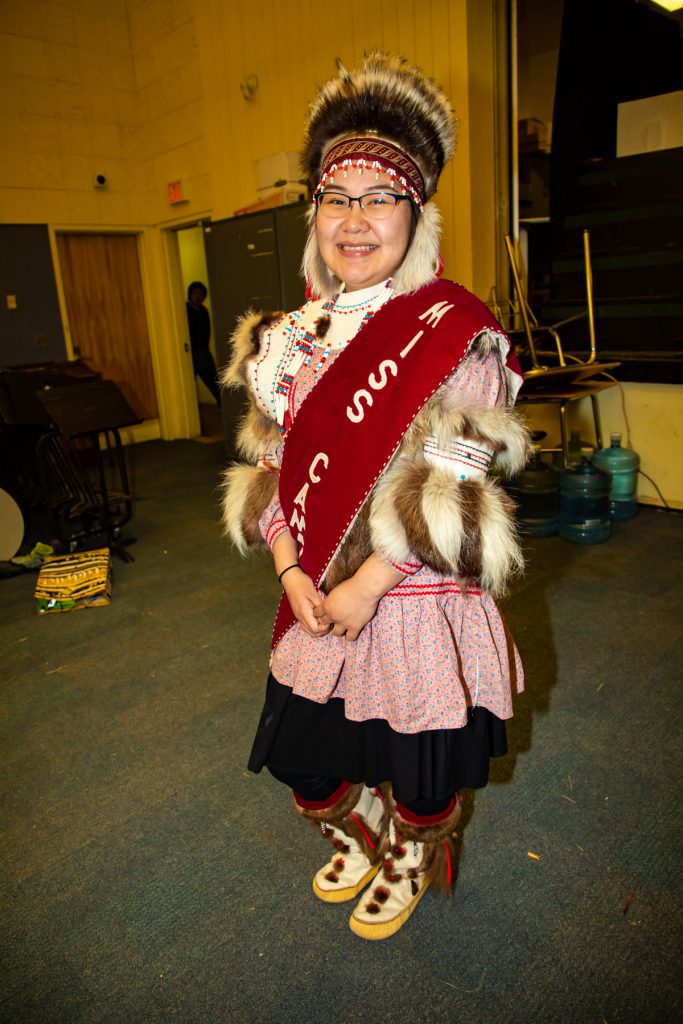- Together we Dance! - April 25, 2019
Ilakluta Ataucitun Yurarukut
(Together We Dance as One)
Cama-i Dance Festival is a place to tell family stories in a variety of ways. This Bethel community event brings volunteers, dancers, and fans together under one roof sharing their native culture through entertainment.

“It’s like a sport to me,’ said 12-year-old, Mia Danie, who has danced at the festival since she was in kindergarten. “I really like sharing my culture, sharing what I can do, and sharing the stories.’
This year’s three-day event at the Bethel Regional High School, drew approximately 500 attendees who joined, shared or just watched activities throughout the school. Classrooms, school lobby, and gym were used to promote positive energy through dance, “Up Close and Personal’ type seminars, a “Miss Cama-i “contest, Heart of the Drum (drumming circle), Memoriam slideshow, Quilt raffle, crafts tables, Yukon Kuskokwim Health Corporation-Dental Clinic, Fur Fashion Show, Storytelling, and special workshop creations.
The 2019 festival brought groups as far as Seneca, NY, Sandofa African Dancers based in Tennessee, and regional traditional groups. The event’s cross-cultural mix dates back to 1989, when festival organizers expanded the beyond local dancers. As Pat Desmet, light and sound coordinator for 30 years reflected, “Cama-i is about promoting dances in the villages and to see the different villages return to their native yuraq (dance)’ he said. “It is a way to bring people together with many styles of dance.’
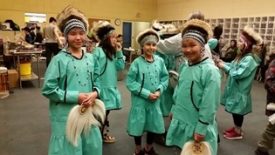
Over time, the festival has expanded along with participants. Lighting a Flame with three candles started in 1994 to represent youth, adult and elders. Random people are selected from each age group to light the candle. If family members sitting in the audience span generations, they may be asked to participate in the lighting ceremony. The flame is lit every day at the start of the event and is blown out every evening to close the day’s activities. That idea came to Desmet as he watched the Olympics.
Among this year’s Saturday dance highlights: K-6 grade school kids, Sampson Brothers & Family Hoop Dancers, Sankofa African Dancers and Drum Ensemble, Delta Illusion Dance Company, and Heart of the Drums. Scheduled dance groups, taught their style of dance performance dressed in their custom regalia. Some dance messages reflect hunting, ceremonies, and traditions in crafts.
The yuraq headdress that the 6th-grade dancers wore is called Nasqurrun, or Nasqurrutek in Yup’ik and Cup’ik culture. The headdress can be made from wolf, wolverine, weasel, caribou-hair, bear claws, or otter fur-ruff. The clothing regalia dancers wear is a headdress, qaspeq (dress), mukluks (shoes), and fans for the women, and the men wear qaspeq, gloves, and mukluks. The drummers wear only the qaspeq’s, and mukluks.
The Kuskokwim Campus yuraq was about hunting geese. The story told is danced over seven rounds of repetition and motion. Drummers pick up speed accompanying each round. Men used arm motions and geese sounds portraying their story.
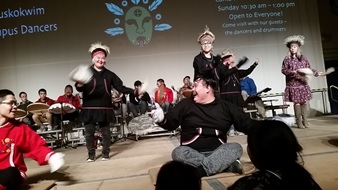
Martha Glore, 58 has danced with the Kuskokwim Campus dancers off and on for 20 years. “This year was memorable,” she said, because her daughter returned to Bethel and danced with her at Cama-i. “To find families who dance traditional style is something I think we take for granted because most families no longer dance.’

Artists from all over the state come to sell their works, which are often inspired by nature. “Everything in nature is a cycle, where each in turn helps man,’ said John Oscar a Bethel artist, whose 3-D art tells stories about animals. Oscar’s piece Surfing Waves, made from driftwood and guinea hen feathers, offers a story about returning home to Mekoryuk from fish camp through strong winds that blew his boat through white caps. Another work, Follow Me Red II, made from driftwood, reindeer hair, and guinea hen feathers, is the story of a fox following trails, looking for food, leaving the remains for insects, which in turn feed the birds.
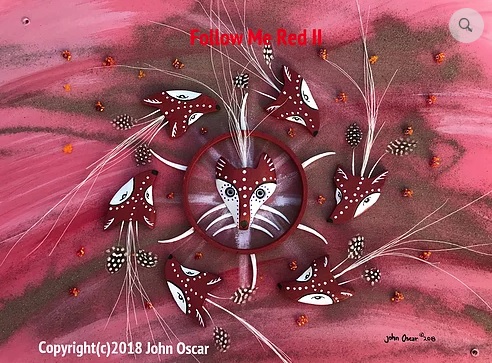
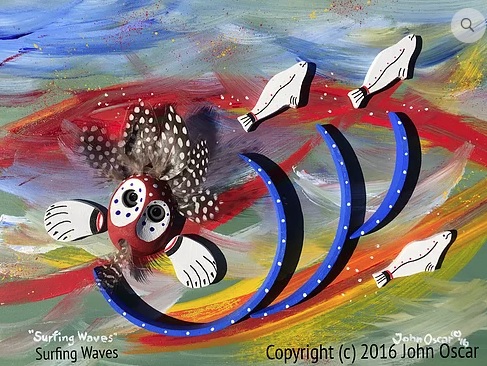
Nikki Corbett, 31, who owns Sew Yup’ik in Kenai, she sells hand-sewn items in rural communities throughout the state. “Cama-i is about coming together to enjoy dancing, family, Yup’ik food, and the beautiful crafts,’ Corbett said
Late Saturday the two finalists for Miss Cama-i were brought on stage after a busy day writing essays, an interview, photo shoot, and serving Elders lunch. Their evening speech to the audience was about their heritage and love for subsistence activities. Lorraine Tom from Chefornak won this year’s Miss Cama-i based on her promotion of Yup’ik language and traditional subsistence activities.
The festival host closed with a quote from a deceased elder from St. Mary’s. “Without ritual, without storytelling, without the drum, without dance,” as the late Andrew Paukan once said, “subsistence is only food.’
